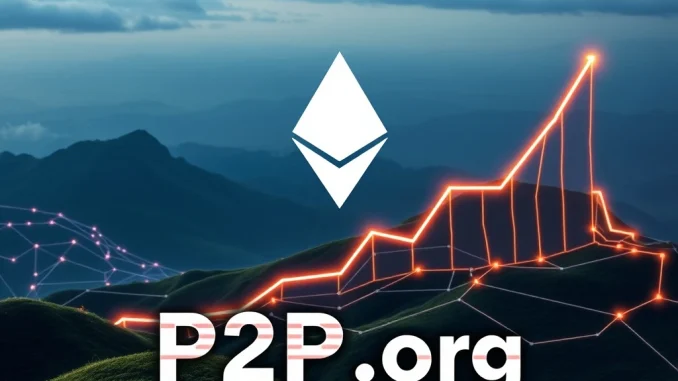
The cryptocurrency market is buzzing, and at the heart of the excitement lies Ethereum, which recently surged past the $3,700 mark. This impressive rally isn’t just about price action; it’s a testament to the robust growth of its underlying ecosystem, particularly in the realm of Ethereum staking. Leading this charge is P2P.org, a prominent staking provider, which has announced a monumental milestone: over 1.2 million ETH, valued at more than $4 billion, is now staked across its services. This incredible achievement underscores a growing confidence in decentralized finance (DeFi) solutions and a pivotal shift in the global regulatory landscape.
Ethereum Staking: A Gateway to Passive Income in the Digital Age
For many, the idea of earning passive income from digital assets was once a niche concept, but with Ethereum’s transition to a Proof-of-Stake (PoS) consensus mechanism, Ethereum staking has become a mainstream opportunity. Instead of relying on energy-intensive mining, PoS allows ETH holders to ‘stake’ their tokens to help secure the network and validate transactions. In return, they earn rewards, effectively becoming active participants in the network’s security and governance. This shift has not only significantly reduced Ethereum’s energy consumption, making it more appealing to environmentally conscious investors, but it has also opened doors for platforms like P2P.org to thrive.
P2P.org’s success is a clear indicator of this burgeoning interest. Their non-custodial staking infrastructure means users retain control over their assets while staking, a crucial factor for security-conscious investors. The platform’s ability to attract such a massive volume of ETH—1.2 million tokens and counting—speaks volumes about its reliability and the trust it has built within the crypto community. This milestone is not just a win for P2P.org; it’s a powerful signal for the entire staking ecosystem, demonstrating the viability and appeal of earning rewards by contributing to blockchain security.
P2P.org’s Remarkable Ascent Fueled by Surging User Engagement
The journey to 1.2 million ETH staked is a story of consistent growth and strategic expansion for P2P.org. The platform has witnessed a significant uptick in user engagement, particularly from the United States, where inquiries have surged by an impressive 30% since July 2025. This growing interest prompted P2P.org to establish its first American office and expand its team with five new roles, signaling a clear commitment to serving the burgeoning U.S. market.
Alex Loktev, P2P.org’s Chief Revenue Officer, highlighted the critical role of a more favorable U.S. regulatory environment in their success. “The momentum in the U.S. regulatory landscape has been critical to our record-breaking user growth,” Loktev stated, emphasizing the company’s ambitious goal to become the primary staking provider for institutions, individuals, and even governments. This strategic move positions P2P.org at the forefront of institutional adoption, bridging the gap between traditional finance and the decentralized world.
Key metrics further underscore P2P.org’s expanding influence within the DeFi ecosystem:
- Total Value Locked (TVL) in Ethereum Staking: Over the past 30 days, P2P.org’s TVL grew to a staggering 35,774,027 ETH, showcasing the immense capital flowing into their staking services.
- New Validators: The network added 19,540 new validators in July alone, indicating robust participation and a healthy, decentralized network.
- User Activity: Approximately three million new wallet addresses joined the network during the same period, marking an all-time high in user engagement.
- Staking Inflows: Inflows began rising in April and accelerated sharply after June, reflecting renewed interest from both retail and institutional clients looking to capitalize on Ethereum’s bullish momentum.
These figures paint a clear picture of a platform experiencing exponential DeFi growth, driven by strong market fundamentals and a strategic approach to user acquisition and regulatory compliance.
The ETH Price Surge: What’s Driving Ethereum’s Ascent Beyond $3.7K?
Ethereum’s recent push past the $3,700 mark is not an isolated event; it’s part of a broader bullish trend in the crypto market, significantly bolstered by several key developments. The ETH price surge is intrinsically linked to growing confidence in the asset’s utility, scalability, and future prospects. One of the most significant catalysts has been the increasing clarity around US crypto regulation and the approval of Ethereum-based Exchange Traded Funds (ETFs).
The approval of spot Bitcoin ETFs earlier in the year paved the way for similar products for Ethereum, legitimizing the asset in the eyes of traditional investors and opening floodgates for institutional capital. These ETFs provide a regulated and accessible way for a wider range of investors to gain exposure to Ethereum without directly holding the cryptocurrency, thereby reducing perceived risks and compliance hurdles. This influx of new capital, combined with Ethereum’s successful transition to Proof-of-Stake, has created a powerful positive feedback loop.
Furthermore, Ethereum’s post-merge PoS model offers several advantages that appeal to a diverse investor base:
- Energy Efficiency: The drastic reduction in energy consumption addresses environmental concerns, attracting ESG-focused investors.
- Yield Generation: Staking rewards offer a compelling yield, making ETH an attractive asset for those seeking passive income opportunities.
- Network Security: A more robust and decentralized network, secured by a larger pool of staked ETH, enhances confidence in the ecosystem’s long-term stability.
These factors collectively contribute to a favorable market environment for staking platforms like P2P.org, which are perfectly positioned to capitalize on the increasing demand for secure and scalable staking solutions. Their emphasis on accessibility and user control has undoubtedly accelerated adoption, particularly among retail investors eager to optimize returns during Ethereum’s bull cycle.
Navigating US Crypto Regulation: A Catalyst for Unprecedented Growth?
The evolving landscape of US crypto regulation has been a game-changer for the digital asset industry. Historically, regulatory uncertainty has been a significant barrier to mainstream adoption, particularly for institutional players. However, recent developments, including clearer guidelines for crypto staking and the landmark approval of Ethereum-based ETFs, have provided much-needed clarity and confidence.
This shift has been instrumental in driving institutional and retail participation. When regulators provide a framework, it signals a move towards legitimization, reducing the fear of unforeseen legal challenges and enabling traditional financial institutions to engage with crypto assets. For platforms like P2P.org, this regulatory clarity translates directly into increased trust and accelerated user growth. The company’s decision to open an office in the U.S. and expand its local team is a direct response to this positive regulatory momentum, aiming to serve the growing demand from American investors and institutions.
While the regulatory environment appears more favorable, it’s crucial to acknowledge that the landscape is still dynamic. Companies operating in the crypto space must remain agile and adaptive, continuously monitoring new legislative developments to ensure compliance. P2P.org’s proactive approach to understanding and engaging with regulators positions it well for sustained growth in this evolving environment, aiming to set a benchmark for responsible and secure staking services.
The Future of DeFi Growth and P2P.org’s Vision
The current surge in DeFi growth, exemplified by P2P.org’s achievements, points to a vibrant and expanding ecosystem. However, sustaining this momentum requires continuous innovation and a steadfast commitment to core principles. The DeFi landscape is highly competitive, with new platforms and services emerging regularly. For P2P.org to maintain its leadership position, it must prioritize:
- Security: As the amount of staked ETH grows, so does the target for potential attacks. Robust security measures and continuous audits are paramount to protecting user assets.
- Scalability: The platform must be able to handle increasing volumes of users and transactions without compromising performance or reliability.
- User Trust: Transparency, excellent customer support, and a consistent track record of reliable service are essential for building and maintaining user confidence.
- Adaptability: The crypto market is fast-paced. P2P.org’s ability to adapt to new technological advancements, market conditions, and regulatory shifts will be critical for long-term success.
P2P.org’s ambition to become the primary staking provider for a wide array of clients, including institutions and governments, sets a high bar. Their current success is a strong foundation, but the journey ahead will demand constant vigilance and strategic foresight. As Ethereum’s price and market conditions continue to evolve, platforms like P2P.org will play a crucial role in onboarding the next wave of users into the decentralized economy, making staking accessible and secure for everyone.
The remarkable achievements of P2P.org—hitting 1.2 million ETH staked amidst Ethereum’s surge past $3,700—are a powerful indicator of the cryptocurrency market’s maturity and the increasing demand for decentralized financial services. Fueled by a more favorable US crypto regulation environment and the inherent benefits of Ethereum staking, platforms like P2P.org are not just facilitating passive income; they are actively shaping the future of finance. Their continued focus on security, scalability, and user trust will be paramount as they navigate the competitive landscape and drive further DeFi growth, ultimately contributing to a more robust and accessible decentralized world.
Frequently Asked Questions (FAQs)
1. What is Ethereum staking and why is it important?
Ethereum staking is the process of locking up ETH tokens to help secure the Ethereum network and validate transactions, following its transition to a Proof-of-Stake (PoS) consensus mechanism. It’s important because it contributes to the network’s security, decentralization, and energy efficiency, while allowing ETH holders to earn passive income (rewards) for their participation.
2. What makes P2P.org a notable platform for Ethereum staking?
P2P.org stands out due to its non-custodial staking infrastructure, meaning users retain control over their assets. Its recent milestone of 1.2 million ETH staked, coupled with significant user growth and expansion into the U.S. market, highlights its reliability, user-friendliness, and strategic positioning within the growing DeFi sector.
3. How have US regulatory shifts impacted the crypto market and staking platforms?
Recent shifts towards clearer U.S. crypto regulation, including guidelines for staking and the approval of Ethereum-based ETFs, have significantly boosted market confidence. This regulatory clarity reduces uncertainty for institutions and retail investors, leading to increased participation and capital inflow into the crypto market, directly benefiting staking platforms like P2P.org.
4. What are the benefits of staking Ethereum for an individual investor?
For individual investors, staking Ethereum offers several key benefits: the opportunity to earn passive income (staking rewards) on their ETH holdings, contributing to the security and decentralization of the Ethereum network, and participating in a more environmentally friendly blockchain ecosystem post-merge.
5. What are the potential challenges or risks associated with ETH staking?
While beneficial, ETH staking does carry risks. These include ‘slashing’ (penalties for validator misbehavior), liquidity risk (staked ETH may be locked for a period), smart contract risks, and price volatility of ETH itself. Choosing a reputable and secure staking provider like P2P.org can help mitigate some of these risks.
6. How does DeFi growth relate to P2P.org’s success?
DeFi growth refers to the expansion of decentralized financial services, including lending, borrowing, and staking. P2P.org’s success is directly linked to this growth, as it provides essential infrastructure for Ethereum staking, a core component of the DeFi ecosystem. The increasing demand for decentralized financial solutions fuels the adoption of platforms like P2P.org.



